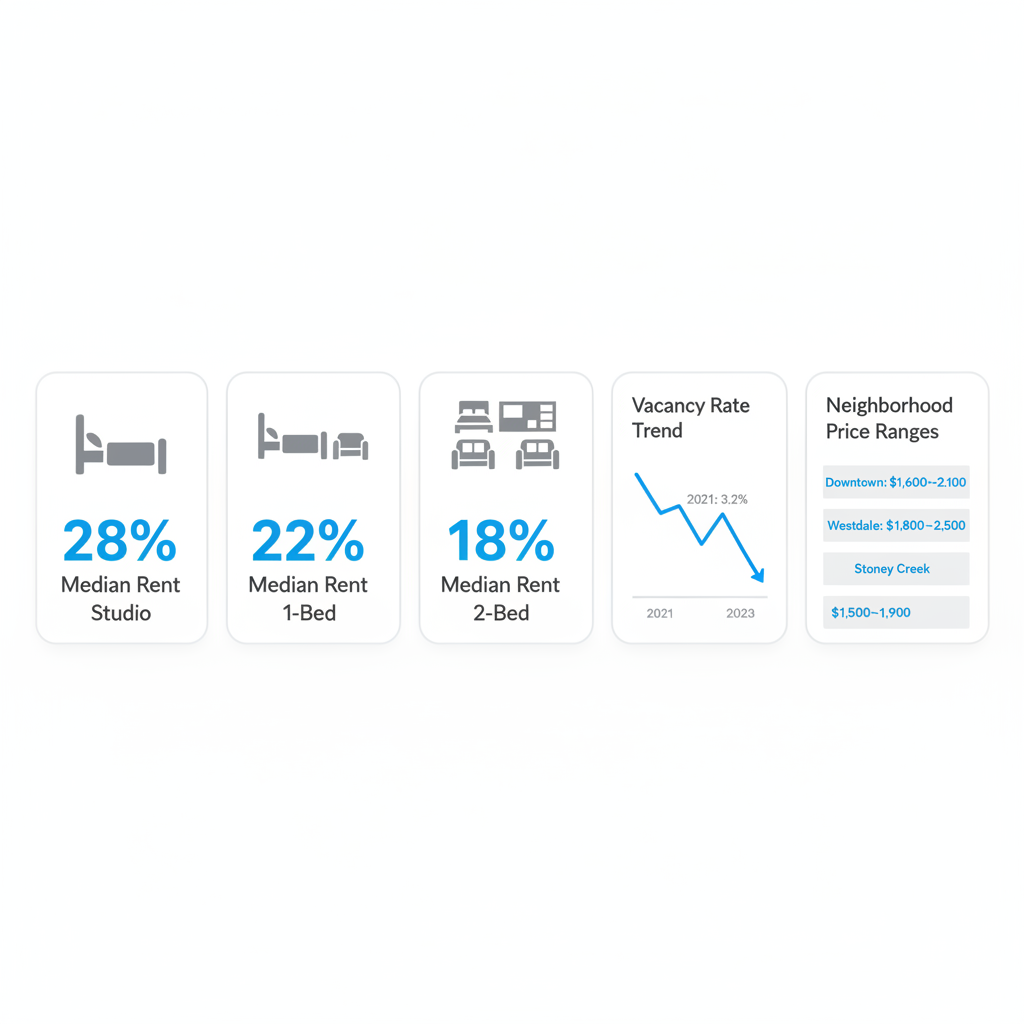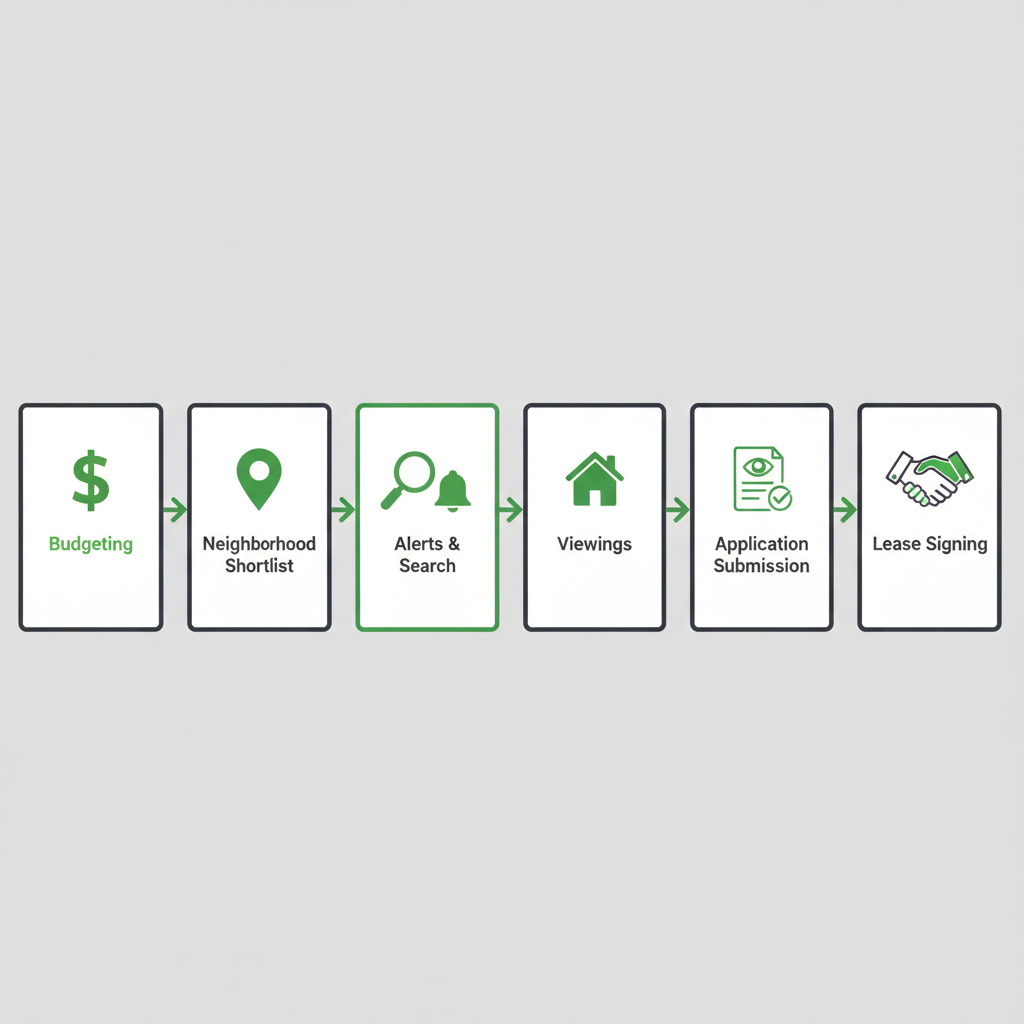Table of Contents
Renting In Hamilton Basics
Why This Guide Helps
Whether you’re a first-time renter, a relocating professional, or a student looking for your own space, navigating Hamilton’s ever-evolving rental landscape can seem daunting. This guide is crafted to demystify the process by covering the essentials: from understanding neighborhoods and average rents to finding listings, pet policies, and preparing your application with confidence. Hamilton offers a spectrum of choices, making it vital to know what to expect and how to approach your search–be it for downtown hamilton apartment rentals or a quiet suburban suite. Leverage this resource as your step-by-step roadmap, ensuring every stage–budgeting, shortlisting, applying–is informed by current market insights and the best industry practices.
Quick Hamilton Snapshot
Hamilton’s rental market attracts a diverse mix of renters, drawn by a more attainable cost of living than Toronto, strong transit, and a richly textured urban vibe. In August 2025, the average rent in the city reached $2,080 per month, with a one-bedroom averaging $1,763 and two-bedrooms $2,139 (Rentals.ca Hamilton). Studio units, while less common, offer affordable entry points for those on a budget. Neighbourhoods range from the energetic Downtown–popular among students and young professionals–for bachelor and one-bedroom options, to spacious suburban family zones in places like Stoney Creek and Ancaster. Amenities, building age, and proximity to campus or GO transit remain key drivers of price variation and competition.
How To Read This Guide
Each section answers a critical aspect of the Hamilton rental journey: fundamentals (types and costs), where to search, current trends, interpreting market data, search step-by-step instructions, unit vetting tips, and pro negotiation advice. If you’re seeking the best hamilton apartments rentals or want to compare rent across neighborhoods, simply jump to the relevant heading in the Table of Contents below. Use FAQs and comparison charts to quickly find what matters most–whether it’s pet policies, price benchmarks, or how to assemble a winning application.
Hamilton Rental Fundamentals
Apartment Types And Costs
Hamilton’s rental landscape spans a broad range of unit types and price points. Studios provide compact efficiency–mainly in Downtown and near transit hubs–ideal for students and singles. One-bedrooms offer privacy with a separate living area, favored by couples or young professionals. Two-bedroom units, often found in family-oriented neighborhoods, cater to small families or roommates. Basement suites and purpose-built rentals, sometimes offering more opportunity for negotiation, can offer distinct value. Typical amenities across most complexes include laundry, on-site parking, and secure building entry, but higher-end units might also feature gyms, pools, or even coworking lounges. The city’s mix of modern and heritage buildings creates broad rent variance, emphasizing the need to match your priorities against available options.
Apartment Types Comparison
Type Typical Rent Common Areas Best For
| Studio | $900-$1,200 | Downtown, near transit | Students, single professionals |
| 1 Bedroom | $1,100-$1,500 | Central, suburban nodes | Couples, young professionals |
| 2 Bedroom | $1,400-$1,900 | Family neighborhoods | Small families, roommates |
Hamilton’s pool of furnished corporate apartments hamilton is tailored for business travelers or those seeking short-term comfort, generally priced above comparable unfurnished units. For those seeking proximity to campus, mcmaster student apartments hamilton near campus provide a convenient, energetic lifestyle–typically in purpose-built or converted rental homes.
Average Rent Benchmarks
As of August 2025, studio apartments in Hamilton typically lease for $900-$1,200, while one-bedrooms average about $1,763, and two-bedrooms climb to around $2,139 (Rentals.ca Hamilton). These numbers reflect a clear yearly increase, especially in popular areas and new builds. Seasonality also matters: rents peak in late spring and early summer, reflecting increased demand from students and relocating professionals. According to recent CMHC rental market data, vacancy rates in the city remain low, creating a competitive landscape for renters.
- CMHC rental data reports average one-bedroom rents at a record high in 2024-25
- Rentals.ca shows Hamilton rents remain below Toronto but are catching up every year
- Utilities and parking may or may not be included; always confirm in the listing
Where Listings Appear
Finding your ideal hamilton rental apartment starts with knowing where to search. Online marketplaces like Rentals.ca and local resources such as HamiltonRentals.ca offer an exhaustive range of options, frequently updated to reflect real-time availability. Property management companies, notably those specializing in verified listings or tailored searches (e.g., for pet-friendly or accessible units), provide added security in screening and communication. Community boards–online and neighborhood-based–can be fruitful for sublets or budget-friendly arrangements, but expect limited vetting. Always use internal sources for up-to-date listings and a more personalized search experience.
Market Trends and Benchmarks
Recent Supply And Demand
Hamilton’s rental market has seen significant changes over the past few years, shaped by new developments and persistent demand from newcomers, students, and affordability-seeking migrants from Toronto. In 2024, one-bedroom apartment rents hit historic highs, driven by strong demand and limited new supply. Areas like Downtown and West Harbour experienced construction of condos and high-density rentals, while family-oriented regions saw modest additions. The market is characterized by low vacancy rates, meaning units turn over fast and often command premium prices. Commuter trends–boosted by GO transit connectivity–continue to fuel demand for proximity to transit stations and downtown offices.
Neighborhood Price Differences
Rental prices in Hamilton reflect each neighborhood’s blend of amenities, transit, and lifestyle:
- Downtown: Lively, urban, close to nightlife and McMaster. Typical 1-bed rents: $1,300-$1,700. Best for young professionals, students, those valuing walkability.
- West Harbour: Emerging waterfront, mixed-use projects. 1-bed rents: $1,200-$1,600. Best for commuters, couples.
- Stoney Creek: Suburban, family-focused, access to highways. 1-bed rents: $1,000-$1,350. Best for families, drivers.
- Ancaster: Premium, scenic, quieter. Rents trend higher, amenities cater to established professionals and families.
These zones offer a distinct renter fit, emphasizing the importance of aligning your lifestyle and commuting needs with your preferred location.
Neighborhood Rental Comparison
Neighborhood Typical 1-Bed Rent Transit Score Best For
| Downtown | $1,300-$1,700 | High | Young professionals, students |
| West Harbour | $1,200-$1,600 | Medium | Commuters, couples |
| Stoney Creek | $1,000-$1,350 | Low-Medium | Families, drivers |
Rental Market Data Sources
To make data-informed rental choices, reference both CMHC tables (official vacancy and average rent) and Rentals.ca for real-time asking prices and neighborhood-specific insights. CMHC data is invaluable for context and year-over-year trends but can lag current listings. Rentals.ca and internal platforms offer granular, up-to-the-minute perspectives–vital during competitive periods or when seeking niche options like pet-friendly or furnished units. For market changes, examine both seasonal updates and recent listing activity.

Hamilton rental market benchmarks: median rents and vacancy rate trends.
Finding And Applying Successfully
Search Workflow
The rental journey follows a defined sequence:
- Budgeting: Assess monthly maximum (including utilities/parking).
- Neighborhood Shortlist: Identify 2-4 suitable areas based on commute and lifestyle.
- Alerts & Search: Set up personalized search alerts on trusted platforms like hamilton apartments rentals for real-time matches.
- Contact: Reach out to property managers or landlords for viewing appointments.
- Prepare Application: Compile documents–ID, proof of income/employment, credit report, references.
- Apply Fast: Submit a complete and accurate application. Consider including a cover letter for competitive units.
This stepwise workflow increases your chances of landing high-demand properties and reduces the likelihood of missing deadlines or desirable listings.
Viewing And Vetting Units
A thorough in-person or virtual viewing is essential. Prioritize units with clear maintenance history and look for: working appliances, updated windows/doors, adequate heating and water pressure, no visible water damage or mold, and enough storage. Ask about sound insulation, pest control, and any recent renovations. Red flags include reluctance to answer questions, deferred maintenance, or unlisted fees. Prepare questions for your landlord/property manager–about subletting, visitor rules, and safety measures–to ensure transparency.
Application Checklist
Hamilton’s rental market rewards organized applicants. Include:
- Government ID
- Employment letter (recent paystub or job offer)
- Credit check printout
- Two landlord or character references
- Rental history summary
Complete the packet before viewings, as units can fill within days–especially in segments like downtown hamilton apartment rentals. Double-check submission requirements and follow up promptly for units you prioritize.

Step-by-step guide to finding and securing your ideal rental property.
Search Channels Comparison
Channel Pros Cons Best Use
| Online Marketplaces | Fast, searchable | Scams, duplicates | Initial search/alerts |
| Property Managers | Verified units | Less flexible | Stable rentals, longer leases |
| Local Listings | Hidden gems | Less volume | Budget options, sublets |
Tip: Always visit the property (in person or virtually) before applying. Prioritize listings with verified photos/videos to reduce the risk of scams or undisclosed issues.
Negotiation And Lease Strategies
Lease Clauses To Watch
Toronto-level market pressures make it crucial to scrutinize lease agreements. Look for terms on:
- Length and renewal conditions
- Utilities: what’s included/excluded
- Maintenance: who handles minor repairs
- Subletting and guest policies
It’s wise to negotiate ambiguous or unfavorable clauses, request addenda for pets, or clarify renewal timing in writing.
Pet Policy Negotiation
Pet-friendliness varies and is rarely guaranteed, despite growing demand. Pet deposits and monthly surcharges are common; so too are size/breed restrictions. When seeking units, use filtered searches for pet-friendly options and prepare a ‘pet resume’–with vet records and references–to underscore your credibility as a tenant.
Pet Policy Comparison
Policy Typical Cost Restrictions Renter Tips
| No Pets | $0 | No animals allowed | Ask about exceptions/service pets |
| Cats Allowed | $200-$500 | Indoor cats only | Provide references, vet records |
| Dogs Allowed | $200-$800 or +$25/mo | Breed/size limits | Offer pet resume, meet-and-greet |
Long-Term Planning
Smart renters plan lease renewals and budget for increases as the Hamilton market rises. Consider locking in rates with a multi-year term if offered favorable conditions or if you anticipate upward movement in rents. Evaluate shifting needs–work-from-home space, proximity to new transit–well before your next renewal.
Final Renting Takeaways
Key Action Steps
Set your max monthly budget, shortlist preferred neighborhoods, set up real-time alerts (internal platforms like Found Spaces), assemble your full application packet, and clarify any pet policies early in the process.
Where To Go Next
For up-to-date Hamilton rental inventory and data, continue your search on internal resources and review authoritative data for a competitive edge. Start exploring units at hamilton apartments rentals and uncover city centre options through downtown hamilton apartment rentals.
Resources
Hamilton Rental Apartment Downtown Hamilton Apartment Rentals
